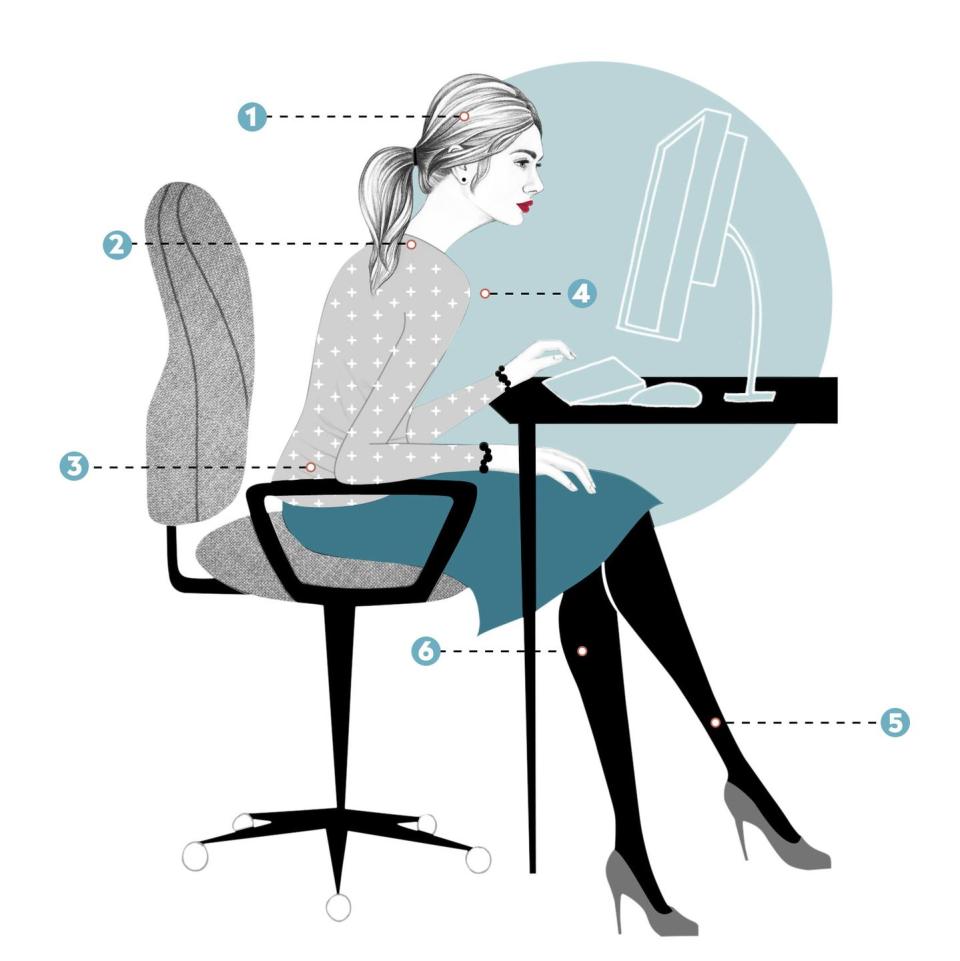6 Serious Health Effects of Sitting All Day, According to Doctors

Sitting Disease. It sounds like some mysterious condition you’d bring back from an exotic vacation, but it’s actually a modern homegrown ailment caused by going from the breakfast table to the driver’s seat, from your desk to the car to the sofa for the evening, with little movement otherwise.
The staggering amount of time many of us spend being sedentary—up to 15 hours a day if we work in an office, according to one study—can lead to problems inside and out. You're probably familiar with the aches and pains caused by hunching over a computer, but spending too much time in a chair or slumped on the sofa also has been linked to several life-threatening conditions, including blood clots, nonalcoholic fatty liver disease, heart disease, and cancer. Not even your brain is spared: In April 2018, researchers at UCLA published a study that found an association between sedentary behavior and thinning of the regions of the brain that are associated with memory formation, meaning that your ability to remember could suffer.
The issue with sitting goes beyond concern about obesity, although being overweight can increase the risk of many of the same conditions linked to sitting too much. And yes, clocking so many hours in your seat can make it harder to maintain a healthy weight: “When you’re sitting, you’re burning only half the calories you would standing or walking lightly,” says David A. Alter, M.D., Ph.D., chair of cardiovascular and metabolic research at the UHN-Toronto Rehabilitation Institute.
But even if you’re trim, a sedentary lifestyle may still wreak havoc on your health. That’s because “lack of movement affects how we burn fat and metabolize sugar and the body’s response to insulin,” Dr. Alter says. Your cholesterol may also go up, along with markers of inflammation and troponins (a protein produced by cardiac muscle cells when they’re hurt or dying). Such physiological changes can nearly double your odds of diabetes and increase your risk of cardiovascular disease by 14%, research shows.
In a small study conducted by the University of Liverpool, researchers took a group of healthy young adults who regularly clocked at least 10,000 steps a day and had them cut back to 1,500 steps. Participants still went to work and took care of their families, says Dan Cuthbertson, Ph.D., of the University of Liverpool’s Institute of Ageing and Chronic Disease. It was no surprise that within two weeks, subjects increased total body fat, particularly around their middles, and lost muscle mass. But strikingly, the group also experienced a decrease in insulin sensitivity and an increase in both fat accumulated in the liver and triglycerides. Staying sedentary had consequences that were both swift and potentially serious in the long term. These changes were all reversible when participants resumed their normal activity regularly.
The health effects of sitting too much
Sitting as much as many of us do increases our chance for some 35 serious conditions, likely because getting up and moving around is key for regulating proteins, genes, and other systems that lower our susceptibility to disease. Below, the effects of “sittingitis”:

1. Depression and anxiety
The more you sit at work, the greater your risk, even if you exercise, a study in Mental Health and Physical Activity found. On the flip side, other research shows that the more people move throughout the day, the happier they are.
2. Back and neck pain
Just four hours of sitting can compress a key disc in your lower back, says Gregory Billy, M.D., associate professor of orthopedics and rehabilitation at Penn State University. Poor posture can also lead to disc problems in your neck, such as a herniated disc.
3. Cancer
Risk of colon and endometrial cancer goes up even after accounting for exercise, possibly due to inflammation, weight gain, and other changes. One review in the Journal of the National Cancer Institute reports that for every additional two hours per day spent sitting, risk jumps 8 percent and 10 percent for colon cancer and endometrial cancer respectively.
4. Obesity, diabetes, and heart trouble
Yes, you burn fewer calories sitting, but also the hormone insulin’s ability to move glucose out of blood and into cells may decline when you sit for long periods, Dr. Alter says. Cholesterol and markers of inflammation may go up; how you metabolize fat changes; and vascular function may be reduced.
5. Weak bones
Weight-bearing exercise, including standing and walking, stresses your skeleton in a good way, signaling specialized cells to replace old bone tissue with new. When you sit too much, the body replaces less of what it loses, leading to fragile bones and a greater risk of osteoporosis, especially as you get older.
6. Blood clots
Slow blood flow in the legs from a sedentary lifestyle, possibly along with lower levels of clot-preventing proteins, increases your risk. A study published in the British Medical Journal found that women who sat for more than 40 hours per week had more than double the risk of a clot moving to their lungs compared with those who sat less than 10 hours.
Can getting more exercise help?
Chairs are hardly a modern invention, but roughly 200 years ago, people sat for just five hours a day. The rest of their waking hours were filled with physical exertion: manually laundering clothes, kneading bread, walking places, working in the garden, you get the idea. If your great-great-great-great-great-great-grandma didn’t swear by her Spin class, it’s as much because she was doing a low-key workout from sunup to sundown as due to the fact that those classes didn’t exist. Today, including eight hours of slumber at night, we may move as little as 60 minutes each day.
Were our ancestors cocooned from the perils of a sedentary lifestyle because they were moving more, or because they weren’t sitting as much? That’s hard to parse, says Dr. Alter. We do know that only 18.7% of American women meet the federal guidelines for physical activity (at least 150 minutes of moderate or 75 minutes of vigorous cardio exercise each week).
There’s no question that hitting those targets can help your health and improve your longevity. But it may take more than double that amount of conscious exercise to offset the time you spend sitting: A study in The Lancet that analyzed data from more than 1 million adults found that it took 60 to 75 minutes of moderate cardio per day to wipe out sitting’s higher risk of premature death. And even the most active participants saw an uptick in mortality risk when they sat in front of the TV for five or more hours a day.
That means exercise, while worthwhile, doesn’t completely make up for sitting. When researchers strapped activity monitors on nearly 8,000 adults 45 and older, they found that sitting for 12 or more hours a day increased the odds of early death regardless of exercise habits. And the risk was especially high if chair time was in uninterrupted stretches of 60 to 90 minutes, says Keith Diaz, Ph.D., the study’s lead author and an assistant professor of behavioral medicine at Columbia University. “It’s simply not enough to be active or move at one specific time of the day,” Diaz says. “We need to be mindful of moving frequently throughout the day in addition to exercising.”
How to mix in more movement
Before you quit your job or swap your washing machine for a washboard and a scrub brush, know this: Moving more doesn’t have to be an all-or-nothing endeavor. You can have your modern life and conveniences (thank you, already-churned butter!) without fear that you’re harming your body. The main trick is to scale back both your sitting and how many consecutive minutes you spend in one seat.
A study from King’s College London showed that people who targeted their sitting time with a specific strategy—say, switching to a standing desk or walking to the water cooler more often—were more effective in reducing their sedentariness than those who focused on adding more exercise sessions into their days.
So work on replacing at least two hours of tush time with movement breaks—a shift associated with all sorts of benefits, including 14 percent lower triglycerides, higher “good” HDL cholesterol, a trimmer waistline, and better glucose control, according to a study in the European Heart Journal. “Little breaks don’t seem like much, but they add up,” says Dr. Alter. In fact, two hours spread over the roughly 16 hours you’re awake is about eight minutes an hour, and you can do those in spurts. One study has shown that adding two minutes more walking to each hour can decrease a person’s risk of dying by 33 percent.
You might also find that there are times you can eliminate sitting entirely. Must you call your sister from the sofa, or could you chat while strolling? What if you prepped dinner while standing at the counter or passed up a seat on the train? The fact that women who sat the most had more than twice the risk of a clot moving to their lungs compared with those who sat the least makes it easier to think of perching as a last resort.

Get moving! Combat your aches and pains and burn more fat with the super-effective walking plan in Prevention’s Walk Your Way to Better Health.
The best way to sit in your chair
Some of the symptoms of too much sitting have to do with the way we sit. “Most of us tend to collapse into our seats so our shoulders roll forward and our back muscles get overstretched,” says Rebecca Seguin, Ph.D., an exercise physiologist and associate professor at Cornell. In an ideal world, this is how you should always position yourself in your chair:
Shoulders back and down
Chin slightly tucked to keep your head in a neutral position
Feet flat on the floor—not crossed or twisted under you
Knees lower than your hips
“Proper alignment also helps you place the least amount of strain on your muscles, ligaments, and bones,” says Stacey Pierce-Talsma, D.O., of Touro University California. That means watching TV head-on (rather than craning your neck) and straightening up when you notice you’re slumping.
A few adjustments to your environment will also help, so move the computer closer to your chair and elevate it so your shoulders and spine aren’t curling forward. In the car, adjust your seat height so that your knees are slightly bent and lower than your hips. A pillow or lumbar support can help thwart slouching and keep your lumbar spine slightly arched, Dr. Pierce-Talsma says. These small tweaks to the way you sit—plus finding ways to work in more non-exercise movement—can lead to huge benefits to your health. That deserves a standing ovation.
Like what you just read? You’ll love our magazine! Go here to subscribe. Don’t miss a thing by downloading Apple News here and following Prevention. Oh, and we’re on Instagram too.
You Might Also Like

